英文小说从要素分析
- 格式:doc
- 大小:77.00 KB
- 文档页数:8
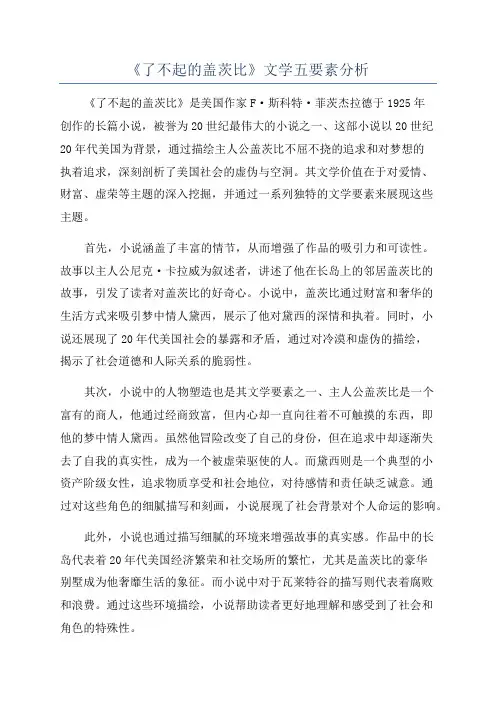
《了不起的盖茨比》文学五要素分析《了不起的盖茨比》是美国作家F·斯科特·菲茨杰拉德于1925年创作的长篇小说,被誉为20世纪最伟大的小说之一、这部小说以20世纪20年代美国为背景,通过描绘主人公盖茨比不屈不挠的追求和对梦想的执着追求,深刻剖析了美国社会的虚伪与空洞。
其文学价值在于对爱情、财富、虚荣等主题的深入挖掘,并通过一系列独特的文学要素来展现这些主题。
首先,小说涵盖了丰富的情节,从而增强了作品的吸引力和可读性。
故事以主人公尼克·卡拉威为叙述者,讲述了他在长岛上的邻居盖茨比的故事,引发了读者对盖茨比的好奇心。
小说中,盖茨比通过财富和奢华的生活方式来吸引梦中情人黛西,展示了他对黛西的深情和执着。
同时,小说还展现了20年代美国社会的暴露和矛盾,通过对冷漠和虚伪的描绘,揭示了社会道德和人际关系的脆弱性。
其次,小说中的人物塑造也是其文学要素之一、主人公盖茨比是一个富有的商人,他通过经商致富,但内心却一直向往着不可触摸的东西,即他的梦中情人黛西。
虽然他冒险改变了自己的身份,但在追求中却逐渐失去了自我的真实性,成为一个被虚荣驱使的人。
而黛西则是一个典型的小资产阶级女性,追求物质享受和社会地位,对待感情和责任缺乏诚意。
通过对这些角色的细腻描写和刻画,小说展现了社会背景对个人命运的影响。
此外,小说也通过描写细腻的环境来增强故事的真实感。
作品中的长岛代表着20年代美国经济繁荣和社交场所的繁忙,尤其是盖茨比的豪华别墅成为他奢靡生活的象征。
而小说中对于瓦莱特谷的描写则代表着腐败和浪费。
通过这些环境描绘,小说帮助读者更好地理解和感受到了社会和角色的特殊性。
总之,《了不起的盖茨比》通过丰富多样的情节、鲜明独特的人物塑造、细腻描绘的环境、巧妙运用的文学手法等文学要素的运用,揭示了20年代美国社会的矛盾和人性的脆弱。
这部小说不仅具有很高的艺术价值,而且深入挖掘了人类社会的本质和困境,对于读者来说具有深远的思考和启示意义。
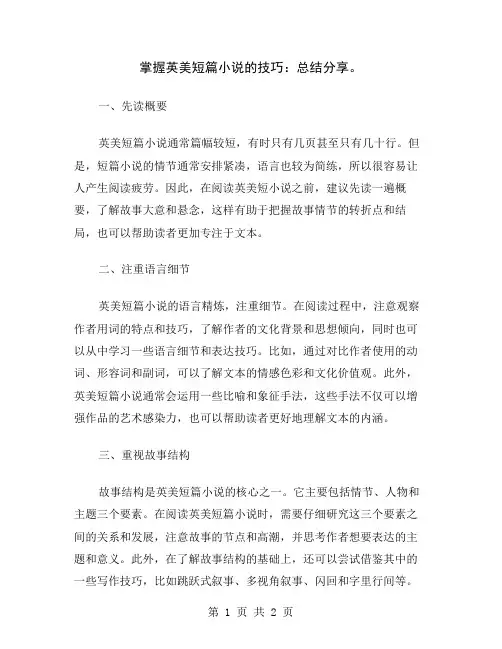
掌握英美短篇小说的技巧:总结分享。
一、先读概要英美短篇小说通常篇幅较短,有时只有几页甚至只有几十行。
但是,短篇小说的情节通常安排紧凑,语言也较为简练,所以很容易让人产生阅读疲劳。
因此,在阅读英美短小说之前,建议先读一遍概要,了解故事大意和悬念,这样有助于把握故事情节的转折点和结局,也可以帮助读者更加专注于文本。
二、注重语言细节英美短篇小说的语言精炼,注重细节。
在阅读过程中,注意观察作者用词的特点和技巧,了解作者的文化背景和思想倾向,同时也可以从中学习一些语言细节和表达技巧。
比如,通过对比作者使用的动词、形容词和副词,可以了解文本的情感色彩和文化价值观。
此外,英美短篇小说通常会运用一些比喻和象征手法,这些手法不仅可以增强作品的艺术感染力,也可以帮助读者更好地理解文本的内涵。
三、重视故事结构故事结构是英美短篇小说的核心之一。
它主要包括情节、人物和主题三个要素。
在阅读英美短篇小说时,需要仔细研究这三个要素之间的关系和发展,注意故事的节点和高潮,并思考作者想要表达的主题和意义。
此外,在了解故事结构的基础上,还可以尝试借鉴其中的一些写作技巧,比如跳跃式叙事、多视角叙事、闪回和字里行间等。
四、不断拓展阅读材料英美短篇小说种类繁多,涉及到很多不同的文学流派和文化背景。
为了更好地掌握英美短篇小说,需要不断拓展阅读材料,涉猎不同的题材和风格,了解不同作者的写作特点和文化背景。
这不仅可以拓展学习者的思维和视野,也可以帮助读者更好地掌握英语语言和文化。
掌握英美短篇小说需要一定的阅读技巧和方法。
通过先读概要、注重语言细节、重视故事结构和不断拓展阅读材料,可以帮助读者更好地理解文本和把握故事情节,提高阅读水平和语言能力。
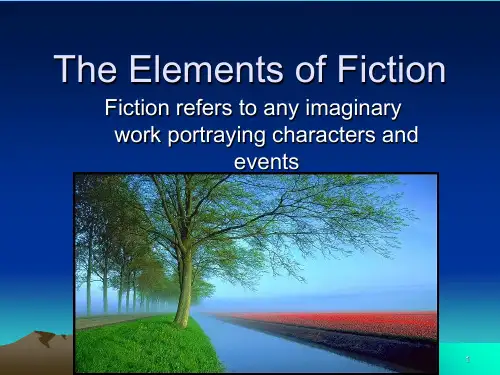

英文小说从要素分析(总8页)--本页仅作为文档封面,使用时请直接删除即可----内页可以根据需求调整合适字体及大小--Elements of Fiction - A Brief IntroductionA. Primary Elements: Plot, Character, Theme, Points of View, Symbol,SettingB. Secondary Elements: Imagery, Irony, Style & Tone, Exposition1. Plot - the sequence of events or incidents of which the story is composed/the arrangement of eventsthat make up a story/the complete pattern or design of the work.A. Conflict is a clash of actions, ideas, desires or wills.a.Person against person.b.Person againstenvironment - externalforce, physical nature,society, or "fate."c.Person againstherself/himself -conflict with someelement in her/his ownnature; maybe physical,mental, emotional, ormoral.d.Person against God-Greek mythology.B. Artistic Unity - essential to a good plot; nothing irrelevant that does not contribute to the total meaning; nothing that is there only for its own sake or its own excitement.C. Plot Manipulation and Fabulation - a good plot should not have any unjustified orunexpected turns or twists, no false leads, and no deliberate and misleading information; fabulation is the introduction of the fabulous or unrealistic or gothic elements in an otherwise realistic setting.D. Story Ending: In a Happy Ending the stereotypical expectation is that the protagonist must solveall the problems, defeat the villain, win the girl, and live happily everafter. Unfortunately, many real life situations have unhappy endings; for the writers of serious fiction, the unhappy endings are more likely to raise significant issues concerning life and living.E. Types of Plot:a. Tragedy(noble)b. Comedy(less great/noble)c. Romance(less great/noble)d. Satire (used to teach lesson or present a point of viewF. Use of Plot:a. The structure of its actionsb. Order: 1st, 2nd, 3rd…c. To create(The author uses actions as a painter uses paints to create)d. To achieve particular words to create certain effect2. CharacterA. Direct Presentation - author tells us straight out, byexposition or analysis, or through another character.B. Indirect Presentation - author shows us the character in action; the reader infers what a character is like from what she/he thinks, or says,or does. These are also called dramatized characters and they are generally consistent (in behavior), motivated (convincing), and plausible (lifelike).C. Character Types - a Flat character is known by one or two traits; a Round character is complex and many-sided; a Stock character is a stereotyped character (a mad scientist, the absent-minded professor, the cruel mother-in-law); a Static character remainsthe same from the beginning of the plot to the end; and a Dynamic (developing) character undergoespermanent change. This change mustbe a. within the possibilities ofthe character; b. sufficiently motivated; and c. allowedsufficient time for change.D. Protagonist and Antagonist - the protagonist is the central character, sympathetic or unsympathetic. The forces working against her/him, whether persons, things, conventions of society, or traits of their own character, are the antagonists.3. Theme - the controlling idea or central insight. It can be 1. a revelation of human character; 2. may be stated briefly or at great length; and 3. a theme is not the "moral" of the story.A. A theme must be expressible inthe form of a statement - not"motherhood" but "Motherhood sometimes has more frustration than reward."B. A theme must be stated as a generalization about life; names of characters or specific situations in the plot are not to be used when stating a theme.C. A theme must not be a generalization larger than is justified by the terms of the story.D. A theme is the central and unifying concept of the story. It must adhere to the following requirements:1. It must account for all the major details of the story.2. It must not be contradicted by any detail of the story.3. It must not rely on supposed facts - facts not actually stated or clearly implied by the story.E. There is no one way of stating the theme of a story.F. Any statement that reduces a theme to some familiar saying, aphorism, or cliché should be avoided. Do not use "A stitch in time saves nine," "You can't judge a book by its cover, " "Fish and guests smell in three days," and so on.。
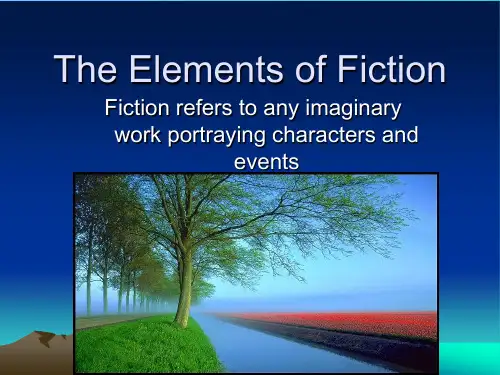
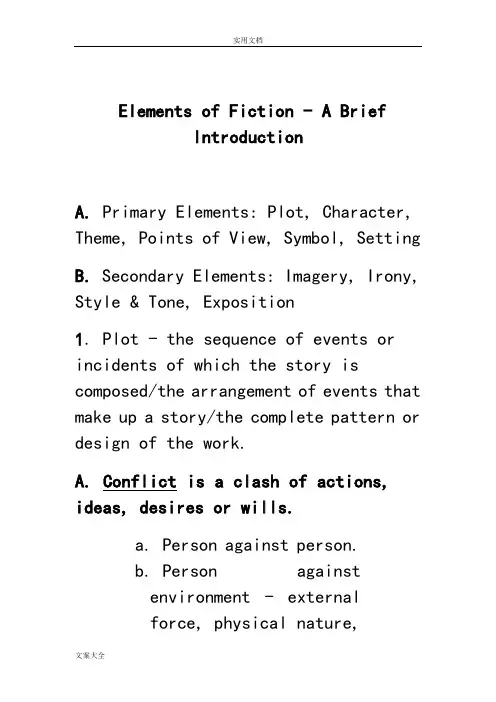
Elements of Fiction - A BriefIntroductionA. Primary Elements: Plot, Character, Theme, Points of View, Symbol, SettingB. Secondary Elements: Imagery, Irony, Style & Tone, Exposition1. Plot - the sequence of events or incidents of which the story is composed/the arrangement of events that make up a story/the complete pattern or design of the work.A. Conflict is a clash of actions, ideas, desires or wills.a.Person against person.b.Person againstenvironment - externalforce, physical nature,society, or "fate."c.Person againstherself/himself -conflict with someelement in her/his ownnature; maybe physical,mental, emotional, ormoral.d.Person againstGod-Greek mythology.B. Artistic Unity - essential to a good plot; nothing irrelevant that does not contribute to the total meaning; nothing that is there only for its own sake or its own excitement.C. Plot Manipulation and Fabulation - a good plot should not have any unjustified or unexpected turns or twists, no false leads, and nodeliberate and misleading information; fabulation is the introduction of the fabulous or unrealistic or gothic elements in an otherwise realistic setting.D. Story Ending: In a Happy Ending the stereotypical expectation is that the protagonist must solve all the problems, defeat the villain, win the girl, and live happily everafter. Unfortunately, many real life situations have unhappy endings; for the writers of serious fiction, the unhappy endings are more likely to raise significant issues concerning life and living.E. Types of Plot:a. Tragedy(noble)b. Comedy(less great/noble)c. Romance(less great/noble)d. Satire (used to teach lesson or present a point of viewF. Use of Plot:a. The structure of its actionsb. Order: 1st, 2nd, 3rd…c. To create(The author uses actions as a painter uses paints to create)d. To achieve particular words to create certain effect2. CharacterA. Direct Presentation - author tells us straight out, by exposition or analysis, or through another character.B. Indirect Presentation - authorshows us the character in action; the reader infers what a character is like from what she/he thinks, or says, or does. These are also called dramatized characters and they are generally consistent (in behavior), motivated (convincing), and plausible (lifelike).C. Character Types - a Flat character is known by one or two traits; a Round character is complex and many-sided;a Stock character is a stereotyped character (a mad scientist, the absent-minded professor, the cruel mother-in-law); a Static character remains the same from the beginning of the plot to the end; and a Dynamic (developing) character undergoes permanent change. This change must be a. within the possibilities of the character; b. sufficiently motivated; and c. allowed sufficienttime for change.D. Protagonist and Antagonist - the protagonist is the central character, sympathetic or unsympathetic. The forces working against her/him, whether persons, things, conventions of society, or traits of their own character, are the antagonists.3. Theme - the controlling idea or central insight. It can be 1. a revelation of human character; 2. may be stated briefly or at great length; and 3. a theme is not the "moral" of the story.A. A theme must be expressible in the form of a statement - not "motherhood" but "Motherhood sometimes has more frustration than reward."B. A theme must be stated as ageneralization about life; names of characters or specific situations in the plot are not to be used when stating a theme.C. A theme must not be a generalization larger than is justified by the terms of the story.D. A theme is the central and unifying concept of the story. It must adhere to the following requirements:1. It must account for all the major details of the story.2. It must not be contradicted by any detail of the story.3. It must not rely on supposed facts - facts not actually stated or clearly implied by the story.E.There is no one way of stating thetheme of a story.F. Any statement that reduces a theme to some familiar saying, aphorism, or cliché should be avoided. Do not use "A stitch in time saves nine," "You can't judge a book by its cover, " "Fish and guests smell in three days," and so on.。

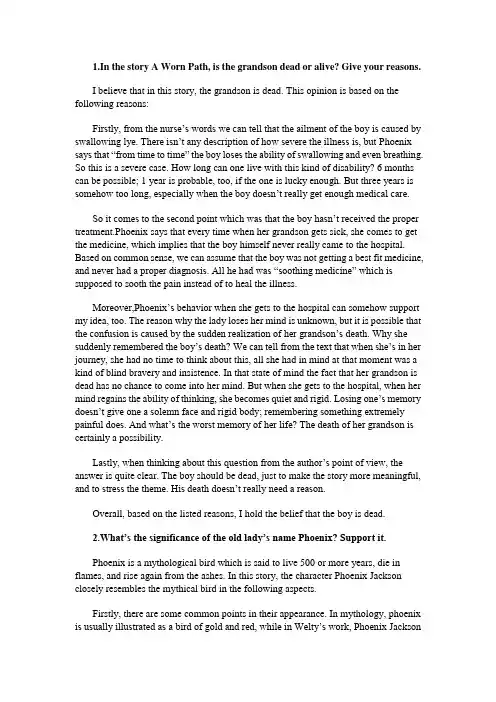
1.In the story A Worn Path, is the grandson dead or alive? Give your reasons.I believe that in this story, the grandson is dead. This opinion is based on the following reasons:Firstly, from the nurse’s words we can tell that the ailment of the boy is caused by swallowing lye. There isn’t any description of how severe the illness is, butPhoenixsays that “from time to time” the boy loses the ability of swallowing and even breathing. So this is a severe case. How long can one live with this kind of disability? 6 months can be possible; 1 year is probable, too, if the one is lucky enough. But three years is somehow too long, especially when the boy doesn’t really get enough medical care.So it comes to the second point which was that the boy hasn’t received the proper treatment.Phoenixsays that every time when her grandson gets sick, she comes to get the medicine, which implies that the boy himself never really came to the hospital. Based on common sense, we can assume that the boy was not getting a best fit medicine, and never had a proper diagnosis. All he had was “soothing medicine” which is supposed to sooth the pain instead of to heal the illness.Moreover,Phoenix’s behavior when she gets to the hospital can somehow support my idea, too. The reason why the lady loses her mind is unknown, but it is possible that the confusion is caused by the sudden realization of her grandson’s death. Why she suddenly remembered the boy’s death? We can tell from the text that when she’s in her journey, she had no time to think about this, all she had in mind at that moment was a kind of blind bravery and insistence. In that state of mind the fact that her grandson is dead has no chance to come into her mind. But when she gets to the hospital, when her mind regains the abil ity of thinking, she becomes quiet and rigid. Losing one’s memory doesn’t give one a solemn face and rigid body; remembering something extremely painful does. And what’s the worst memory of her life? The death of her grandson is certainly a possibility.La stly, when thinking about this question from the author’s point of view, the answer is quite clear. The boy should be dead, just to make the story more meaningful, and to stress the theme. His death doesn’t really need a reason.Overall, based on the listed reasons, I hold the belief that the boy is dead.2.What’s the significance of the old lady’s name Phoenix? Support it.Phoenixis a mythological bird which is said to live 500 or more years, die in flames, and rise again from the ashes. In this story, the character Phoenix Jackson closely resembles the mythical bird in the following aspects.Firstly, there are some common points in their appearance. In mythology, phoenix is usually illustrated as a bird of gold and red, while in Welty’s work, Phoenix Jacks onwears a “red rag” on her head, with a “golden color” running under her wrinkled skin, and a “yellow burning” under her dark cheeks. And considering the lady’s name, from these colors derive the symbolic meaning which links this lady to the mythical bird phoenix.Secondly, the bird phoenix and the ladyPhoenixshare the similarexperience.Phoenixthe lady has a journey through a wood, where, in mythology, is the place that the bird phoenix dwells. Furthermore, just as the phoenix bird has a cycle of life, death and rebirth,Phoenixtakes a dangerous journey through the wood, repeating the process of coming to an obstacle, facing it and overcoming it. We can say that the lady’s journey resembles a cycle of the bird’s life and has the same meaning.Last but not the least, the spirit of the bird phoenix and the lady are almost identical. While the bird suffers from agony of dying in flames to embrace the new life, the lady suffers from the hardship of going through the journey to achieve her goal of getting her beloved grandson some medicine. Both of them go through pains for their greater goal, both of them struggled and both of them succeed. This can actually indicate the same spirit in them.Based on the reasons listed above, the namePhoenixis actually a symbolic element in the story. Linking the lady with the mythical bird, the author is trying to give us a look into the character by the first glimpse.The thorn bush was a large obstacle with an unexpected turn. When she snagged her skirt on this gnarled prickled mass of torture, she barely batted an eye. It caught her attention that her movements were now confined by the bush’s grasp, but she would not allow that to slow her down. Not only did Phoenix find it necessary to keep this dress in a perfect condition, but also knew that if she gave up now a strong feeling of regret would ensue. So, Phoenix pulled free and continued. Obstacles in life are merely meant to test the strength, but when we find ourselves stuck, remember what Phoenix said “Thorns you doin’ y our appointed work. Never want to let folks pass, no sir. Old eyes though you was a pretty little green bush”. She has said that she understands that those obstacles were mere tests and that life will throw them at you at any time. But, then she realizes that if in either human form or in this case, plant form, they are just as innocent as you, and deserve re!spect, no matter how brutal they seem. This was trying to enhance her travel and warn people to watch out for themselves, an attack can be so unexpected, that it can throw you off balance if you aren’t careful.As she passes through a cornfield, Phoenix bumps into an ominous figure swayingback and forth with the piercing wind. At first she merely recognizes it as a dead black man, placed there to act as a deterrent to anyone colored who would like to pass through this field. It...Narrative ElementsThe theme is the central meaning of the narrative, or what the story is about. The plot/structure are elements of the narrative that show the reader how and why different events and incidents occur within the story. The setting shows the reader where the story takes place. The point of view or narration comes in a variety of forms, including first-person, third-person omniscient or third-person limited. Characterization focuses on how the characters in the story are portrayed and what events or actions allow the characters’ true natures to emerge.Theme/Perspective/PlotThe theme of “A Worn Path” is strength in the face of adversity. It is relayed from the third-person point of view, giving the reader just enough distance from the main character and her conflict to see aspects of conflict that she does not. The plot is driven by Phoenix Jackson, an elderly woman who travels a familiar path through the woods to town during Christmas. She is in a hurry to get medicine for her grandson and return to him, and she faces many obstacles over the course of the journey. The tension of the story stems from the obstacles she encounters, which come from nature, society and herself, including barbed wire, a dog, a white hunter, and flashbacks or hallucinations that involve her grandson. CharacterizationJackson is the protagonist of the story, which presents a realistic portrayal of an extremely caring grandmother with possible dementia. The dementia is never stated directly; rather, it is implied through other narrative elements, namely the flashbacks. The story suggests that the grandson died many years ago after swallowing lye but that Jackson continues to believe that he is alive, suffering and in need of medication.Setting and Structure“A Worn Path” is set in the rural South, containing elements of both nature and society. In particular, Jackson travels both through the woods and into town. These two aspects of setting pose different kinds of obstacles for Jackson to overcome. In the woods, she faces the white hunter and the barbed wire, and in town she faces questions that she has trouble answering from the staff in the doctor’s office. The chronological structure of the story shows how she faces and responds to obstacles in present time, and the flashbacks show how she responds to thoughts about her grandson.。
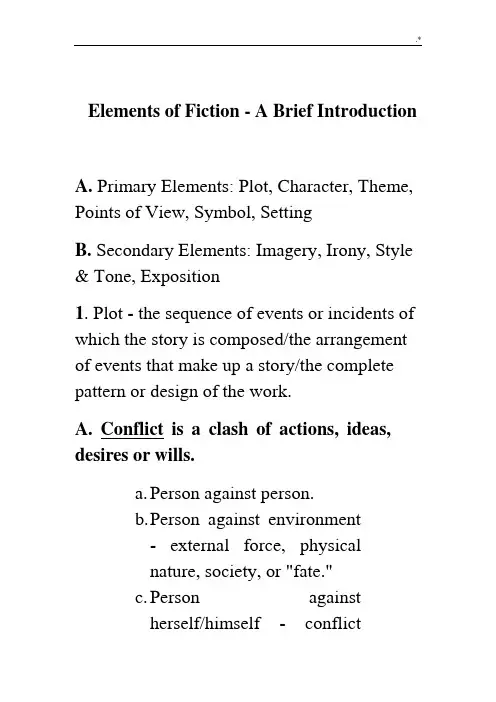
Elements of Fiction - A Brief IntroductionA. Primary Elements: Plot, Character, Theme, Points of View, Symbol, SettingB. Secondary Elements: Imagery, Irony, Style & Tone, Exposition1. Plot - the sequence of events or incidents of which the story is composed/the arrangement of events that make up a story/the complete pattern or design of the work.A. Conflict is a clash of actions, ideas, desires or wills.a.Person against person.b.P erson against environment- external force, physicalnature, society, or "fate."c.Person againstherself/himself - conflictwith some element inher/his own nature; maybephysical, mental, emotional,or moral.d.P erson against God-Greekmythology.B. Artistic Unity - essential to a good plot; nothing irrelevant that does not contribute to the total meaning; nothing that is there only for its own sake or its own excitement.C. Plot Manipulation and Fabulation - a good plot should not have any unjustified or unexpected turns or twists, no false leads, and no deliberate and misleading information; fabulation is the introduction of the fabulous or unrealistic or gothic elements in an otherwise realistic setting.D. Story Ending: In a Happy Ending thestereotypical expectation is that the protagonist must solve all the problems, defeat the villain, win the girl, and live happily everafter. Unfortunately, many real life situations have unhappy endings; for the writers of serious fiction, the unhappy endings are more likely to raise significant issues concerning life and living.E. Types of Plot:a. Tragedy(noble)b. Comedy(less great/noble)c. Romance(less great/noble)d. Satire (used to teach lesson or present a point of viewF. Use of Plot:a. The structure of its actionsb. Order: 1st, 2nd, 3rd…c. To create(The author uses actions as a painter uses paints to create)d. To achieve particular words to create certain effect2. CharacterA. Direct Presentation - author tells us straight out, by exposition or analysis, or through another character.B. Indirect Presentation - author shows us the character in action; the reader infers what a character is like from what she/he thinks, or says, or does. These are also called dramatized characters and they are generally consistent (in behavior), motivated (convincing), and plausible (lifelike).C. Character Types - a Flat character is known by one or two traits; a Round character is complex and many-sided; aStock character is a stereotyped character (a mad scientist, the absent-minded professor, the cruel mother-in-law); a Static character remains the same from the beginning of the plot to the end; and a Dynamic (developing) character undergoes permanent change. This change must be a. within the possibilities of the character; b. sufficiently motivated; and c. allowed sufficient time for change.D. Protagonist and Antagonist - the protagonist is the central character, sympathetic or unsympathetic. The forces working against her/him, whether persons, things, conventions of society, or traits of their own character, are the antagonists.3. Theme - the controlling idea or central insight. It can be 1. a revelation of human character; 2. may be stated briefly or at great length; and 3. a theme is not the "moral" of the story.A. A theme must be expressible in the form of a statement - not "motherhood" but "Motherhood sometimes has more frustration than reward."B. A theme must be stated as a generalization about life; names of characters or specific situations in the plot are not to be used when stating a theme.C. A theme must not be a generalization larger than is justified by the terms of the story.D. A theme is the central and unifying concept of the story. It must adhere to the following requirements:1. It must account for all the major details of the story.2. It must not be contradicted by any detail of the story.3. It must not rely on supposed facts - facts not actually stated or clearly implied by the story.E.There is no one way of stating the theme of a story.F. Any statement that reduces a theme to some familiar saying, aphorism, or clichéshould be avoided. Do not use "A stitch in time saves nine," "You can't judge a book by its cover, " "Fish and guests smell in three days," and so on.。

英美小说要素解析Plot: A Sequence of Interrelated Actions or Events. Plot, or the structure of action, it generally refers to the scheme or pattern of events in a work of fiction. A plot is a plan or groundwork for a story, based on conflicting human motivations, with the actions resulting from believable and realistic human response.Types of Conflict:①External Conflict: Man and nature, man and society, and man and man.②Internal Conflict: It focuses on two or more elements contesting within the protagonist’s own character.Exposition(情节交代): It is where everything is introduced is the beginning section in which the author provides the necessary background information, sets and scene, establishes the situation, and dates the action. It usually introduces the characters and the conflict, or at least the potential for conflict.Complication(纠葛): Which is sometimes referred to as the rising action, develops and intensifies the conflict. The rising action(起始行动) is when things begin to escalate. It takes the reader from the exposition and leads them towards the climax. This part tends to be dramatic and suspenseful.Climax(高潮):When you finally take a breath after holding it in suspense. This is the most emotional part of the book.Crisis(关子):It( also referred to as the climax) is that moment at which the plot reaches its point of greatest emotional intensity; it is the turning point of the plot, directly precipitating the resolution. It is the reversal or” turning point”.Falling action(下降行动):Once the crisis, or turning point, has been reached, the tension subsides and the plot movestoward its conclusion. It is when everything tends to slow down, and the climax is over.Resolution(冲突解开):It is the final section of the plot which records the outcome of the conflict and establishes some new equilibrium. The resolution is also referred to as the conclusion, the end or the denouement. This is the final part of the story when everything is wrapped up. Sometimes the story is finished off completely, answering every reader's question. Sometimes authors leave mysterious, to intrigue the reader. Or sometimes authors leave hints of a sequel.Catastrophe: Applied to tragedy only.Denouement:Applied to both comedy and tragedy.The ordering of plot—Chronological plotting—Flashback: It is interpolated narratives or scenes( often justified, or naturalized, as a memory, a reverie, or a confession by one of the characters) which represent events that happened before the time at which the work opened.Character:They are the persons represented in a dramatic or narrative work, who are interpreted by the reader as being endowed with particular moral, intellectual, and emotional qualities by inferences from what the persons say and their distinctive ways of saying it –the dialogue—and from what they do—the ac tion. A character may remain essentially“stable,”or unchanged in outlook and disposition, from beginning to end of a work, or may undergo a radical change, either through a gradual process of development, or as the result of a crisis. Whether a character remains stable or changes, the reader of a traditional and realistic work expects “consistency”--- ---the character should not suddenly break off and act in a way not plausibly grounded in hisor her temperament as we have already come to know it.Motivation: The grounds in the characters temperament, desires, and moral nature for their speech and actions.Types of characters—protagonist: The chief character in a plot, on whom our interest centers.(or alternatively, the hero or heroine) It is the major, or central, character of the plot.Antagonist: If the plot is such that he or she is pitted against and important opponent, that character is called the antagonist. It is his opponent, the character against whom the protagonist struggles or contends.Flat characters: they are those who embody or represent a single characteristic, trait, or idea, or at most a very limited number of such qualities. Flat characters are also referred to as type characters, as one-dimensional characters, or when they are distorted to create humor, as caricatures.Stock characters: Flat characters have much in common with the kind of stock characters who appear again and again in certain types of literary works. A flat character (also called a type, or “two-dimensional”), Forster says, is built around “a single idea or quality”and is presented without much individualizing detail, and therefore can be fairly adequately described in a single phrase or sentence.Round characters: They are just the opposite. They embody a number of qualities and traits, and are complex multidimensional characters of considerable intellectual and emotional depth who have the capacity to grow and change. A round character is complex in temperament and motivation and is represented with subtle particularity; such a character therefore is as difficult to describe with any adequacy as a person in real life, and like real persons, is capable of surprising us.Dynamic characters: They exhibit a capacity to change; static characters do not. As might be expected, the degree and rate of character change varies widely even among dynamic characters.Static characters: They leave the plot as they entered it, largely untouched by the events that have taken place.Methods of characterization-- Telling: It relies on exposition and direct commentary by the author.In telling, the author intervenes authoritatively in order to describe, and often to evaluate, the motives and dispositional qualities of the characters. Characterization through the use of names, through appearance, and by the author. Showing: It involves the author’s stepping aside, as it were, to allow the characters to reveal themselves directly through their dialogue and their actions. In showing(also called“the dramatic method”), the author simply presents the characters talking and acting and leaves the reader to infer the motives and dispositions that lie behind what they say and do.The author may show not only external speech and actions, but also a character’s inner thoughts, feelings, and responsiveness to events; for a highly developed mode of such inner showing, see stream of consciousness. Characterization through dialogue, and action.Setting: The stage against which the story unfolds.( Place and objects in fiction) The overall setting of a narrative or dramatic work is the general locale, historical time, and social circumstances in which its action occurs; the setting of a single episode orscene within such a work is the particular physical location in which it takes place. Types of setting—Natural and Manufactured The language used in description of settingThe functions of setting: Setting as a background for action,antagonist, a means of creating appropriate atmosphere, a means of revealing character, and a means of reinforcing theme.Point of view: The events of a story may be told as they appear to one or more participants or observers. In first-person narration the point of view is automatically that of the narrator.More variation is possible in third-person narration, where the author may choose to limit his or her report to what could have been observed or known by one of the characters at any given point in the action--- or may choose to report the observations and thoughts of several characters. The author might choose to intrude his or her own point of view.Narrator: It is the speaker or the voice of the literary text, the agent who does the narration. The narrator, like any character in fiction, only exists in a narrative, and he cannot be identified with anything of the real-life author of a literary work.Various points of view—First person:①Advantages: First, he creates an immediate sense of reality. Second, the writer has a ready-made principle of selection.② Difficulties: It may only strike us when we try to write stories ourselves.Second personThird person: There are three variants: omniscient, limited omniscient, and objective or dramatic.Mingling of points of view: It is because for the purpose of sustaining interest or creating suspense.A brief summary: 1. First person( I): All these first-person narrators may have(1) complete understanding,(2) partial or incorrect understanding, or(3) no understanding at all.①Major participantⅰtelling his or her story as a major mover,ⅱtelling a story about others and also about herself or himself as one ofthe major inter-actors,ⅲtelling a story mainly about others; this narrator is on the spot and completely involved but is not a major mover.②Minor participant, telling a story about events experienced and/ or witnessed.③Uninvolved character, tellin g a story not witnessed but reported to the narrator by other means.2. Second person( you): Occurs only when speaker has more authority on a character’s action than the character himself or herself. Occurs only in brief passages when necessary.3. Third p erson( she, he, it, they):①Omniscient. Omniscient speaker sees all, reports all, knows inner workings of minds of characters.②Limited omniscient. Action is focused on one major character.③Dramatic or third-person objective. Speaker reports only actions and speeches. Thoughts of characters can be expressed only as dialogue.Theme: It is the central idea or a statement about life that unifies and controls the total work.Points of theme:1. A theme does not exist as an intellectual abstraction that an author superimposes on the work like icing on a cake.2. The theme may be less prominent and less fully developed in some works of fiction than in others.3. It is entirely possible that intelligent readers will differ, at times radically, on just what the themeof a given a work is.4. The theme of a given work need not be in accord with the reader’s particular beliefs and values. As a general rule, then, we should assume that the ideas of authors grow out of their values, and that values are embodied in their stories along with the ideas. But we must remember that although literature is full of ideas that may strike us, at least initially, as unpleasant, controversial, or simply wrongheaded, literary sophistication and plain common sense should warn usagainst dismissing them out of hand.Identifying theme:1. It is important to avoid confusing a work’s theme with its subject or situation.2. We must be as certain as we can that our statement of theme does the work full.3. The test of any theme we may propose is whether it is fully and completely supported by the work’s other elements.4. The title an author gives the work often suggests a particular focus or emphasis for the reader’s attention.Style: It has traditionally been defined as the manner of linguistic expression in Prose or verse--as how speakers or writers say whatever it is that they say. TheWord style, derived from the Latin word stilus, is understood to mean the way in which writers assemble words to tell the story, develop the argument, dramatize the play, or compose the poem. Style is to be judged on the degree of its adaptability. Elements of style—Diction: Choice of words, and Syntax: Construction of sentences.Oedipus complex: ①It is a term coined by Sigmund Freud to designate a son’s subconscious feel ing of love toward his mother and jealousy and hatred toward his father. ②D.H. Lawrence’s Sons and Lovers is a case in point.Tone: It refers to the methods by which writers convey attitudes, it refers not to attitudes but to those techniques and modes of presentation that reveal or create these attitudes. It is a means of creating a relationship or conveying an attitude.Types of irony:1. Verbal irony: It is a statement in which one thing is said and another is meant.2. Situational irony: It or irony of situation, refers to conditions that are measured against forces that transcend and overpower human capacities.3. Dramatic irony: It is a special kind of situational irony; it applies when acharacter perceives a situation in a limited way while the audience, including other characters, may see it in greater perspective.1.1 The Bride Comes to Yellow Sky—Stephen Crane 1.2 Christmas Day in the Morning—Pearl S. Buck2.1 The Catbird Seat—James Thurber 2.2 Two kinds—Amy Tan3.1 To Build a Fire—Jack London 3.2 A Horseman in the Sky—Ambrose Bierce4.1 A Clean, Well-lighted Place—Ernest Hemingway 4.2 The Broken Globe—Henry Kreisel5.1 Yellow Woman—Leslie Silko 5.2 Rain—W. Somerset Maugham6.1 My Oedipus Complex—Frank O’Connor 6.2 Haircut—Ring Lardner7.1 The Horse D ealer’s Daughter—D.H. Lawrence 7.2 Luck—Mark Twain。

小说分析英文作文范文英文:When it comes to analyzing a novel, there are a few key elements that I always consider. First and foremost, I look at the characters. Are they well-developed and believable? Do their actions and choices make sense based on their personalities and motivations? I also pay attention to the plot. Is it engaging and well-paced? Are there any plot holes or inconsistencies? Additionally, I analyze the setting. Is it well-described and does it add to theoverall atmosphere of the story? Finally, I consider the themes of the novel. What messages or ideas is the author trying to convey? How do they relate to the characters and plot?To illustrate my points, let's take the novel "To Kill a Mockingbird" by Harper Lee as an example. The characters in this novel are incredibly well-developed and believable. We see the world through the eyes of a young girl namedScout, and her observations of the people around her are both insightful and humorous. The plot is also engaging, as we follow Scout's father, a lawyer, as he defends a black man in a deeply racist town. The setting of the novel, a small town in the South during the 1930s, is also well-described and adds to the overall atmosphere of the story. Finally, the themes of the novel, such as racism and prejudice, are incredibly powerful and still resonate with readers today.中文:当谈到分析小说时,我总是考虑几个关键要素。
英文小说的分析报告1. 简介本文是关于一部英文小说的分析报告。
小说是一种文学作品,通过叙述故事和人物塑造来传达作者的思想和情感。
本文将对这部小说的结构、主题、人物、语言运用等方面进行分析,以展现作者的意图和创作技巧。
2. 小说的结构一部小说的结构是指故事的布局和组织方式。
它通常包括开头、发展、高潮和结尾等部分。
通过分析小说的结构,我们可以了解作者如何安排情节、引发读者的兴趣,并营造出紧凑和连贯的叙述节奏。
3. 小说的主题主题是一部小说表达的核心思想或主要观点。
通过分析小说的主题,我们可以深入理解作者对特定话题的思考和见解。
主题可以是关于人性、社会问题、爱情等各种话题。
通过揭示小说的主题,读者可以与作品产生更深层次的共鸣。
4. 小说的人物人物是小说的灵魂,他们通过言行和心理描写来展示作者对人性的理解。
通过分析小说的人物形象和性格特点,我们可以了解作者对不同角色的刻画技巧,以及他们在故事中的作用和发展。
人物的塑造和互动也是小说情节发展的重要驱动力。
5. 小说的语言运用语言是小说的表达工具,通过对语言运用的分析,我们可以了解作者的写作风格和技巧。
例如,作者可能使用富有感情色彩的描写、对话和修辞手法,以营造出特定的氛围和情感效果。
通过分析语言运用,我们可以欣赏作者的文字魅力和表达能力。
6. 总结通过以上对小说的分析,我们可以更好地理解作者的意图和创作手法。
小说作为文学形式的重要组成部分,通过故事和人物塑造来传达情感和思想。
分析小说有助于读者更好地欣赏和理解作品,也为我们自己的写作提供了启示和借鉴。
以上是关于英文小说的分析报告的步骤性思考,通过分析小说的结构、主题、人物和语言运用等方面,我们可以深入了解作者的意图和创作技巧。
阅读和分析小说是提高文学素养和写作能力的重要途径,希望本文能为读者提供一些启发和帮助。
Elements of Fiction - A Brief IntroductionA. Primary Elements: Plot, Character, Theme, Points of View, Symbol, SettingB. Secondary Elements: Imagery, Irony, Style & Tone, Exposition1. Plot - the sequence of events or incidents of which the story is composed/the arrangement of events that make up a story/the complete pattern or design of the work.A. Conflict is a clash of actions, ideas, desires or wills.a.Person against person.b.P erson against environment- external force, physicalnature, society, or "fate."c.Person againstherself/himself - conflictwith some element inher/his own nature; maybephysical, mental, emotional,or moral.d.P erson against God-Greekmythology.B. Artistic Unity - essential to a good plot; nothing irrelevant that does not contribute to the total meaning; nothing that is there only for its own sake or its own excitement.C. Plot Manipulation and Fabulation - a good plot should not have any unjustified or unexpected turns or twists, no false leads, and no deliberate and misleading information; fabulation is the introduction of the fabulous or unrealistic or gothic elements in an otherwise realistic setting.D. Story Ending: In a Happy Ending thestereotypical expectation is that the protagonist must solve all the problems, defeat the villain, win the girl, and live happily everafter. Unfortunately, many real life situations have unhappy endings; for the writers of serious fiction, the unhappy endings are more likely to raise significant issues concerning life and living.E. Types of Plot:a. Tragedy(noble)b. Comedy(less great/noble)c. Romance(less great/noble)d. Satire (used to teach lesson or present a point of viewF. Use of Plot:a. The structure of its actionsb. Order: 1st, 2nd, 3rd…c. To create(The author uses actions as a painter uses paints to create)d. To achieve particular words to create certain effect2. CharacterA. Direct Presentation - author tells us straight out, by exposition or analysis, or through another character.B. Indirect Presentation - author shows us the character in action; the reader infers what a character is like from what she/he thinks, or says, or does. These are also called dramatized characters and they are generally consistent (in behavior), motivated (convincing), and plausible (lifelike).C. Character Types - a Flat character is known by one or two traits; a Round character is complex and many-sided; aStock character is a stereotyped character (a mad scientist, the absent-minded professor, the cruel mother-in-law); a Static character remains the same from the beginning of the plot to the end; and a Dynamic (developing) character undergoes permanent change. This change must be a. within the possibilities of the character; b. sufficiently motivated; and c. allowed sufficient time for change.D. Protagonist and Antagonist - the protagonist is the central character, sympathetic or unsympathetic. The forces working against her/him, whether persons, things, conventions of society, or traits of their own character, are the antagonists.3. Theme - the controlling idea or central insight. It can be 1. a revelation of human character; 2. may be stated briefly or at great length; and 3. a theme is not the "moral" of the story.A. A theme must be expressible in the form of a statement - not "motherhood" but "Motherhood sometimes has more frustration than reward."B. A theme must be stated as a generalization about life; names of characters or specific situations in the plot are not to be used when stating a theme.C. A theme must not be a generalization larger than is justified by the terms of the story.D. A theme is the central and unifying concept of the story. It must adhere to the following requirements:1. It must account for all the major details of the story.2. It must not be contradicted by any detail of the story.3. It must not rely on supposed facts - facts not actually stated or clearly implied by the story.E.There is no one way of stating the theme of a story.F. Any statement that reduces a theme to some familiar saying, aphorism, or clichéshould be avoided. Do not use "A stitch in time saves nine," "You can't judge a book by its cover, " "Fish and guests smell in three days," and so on.。